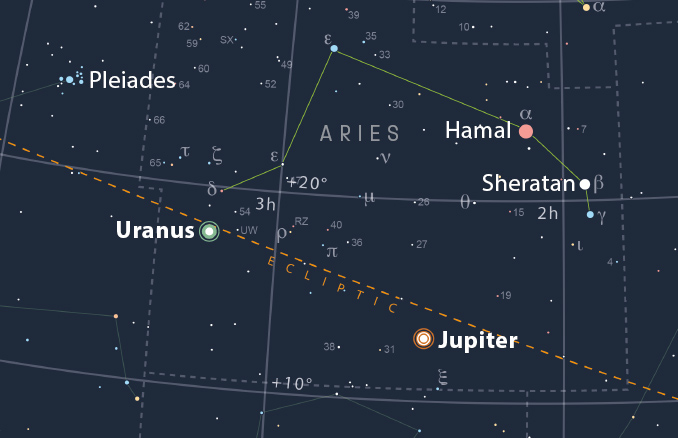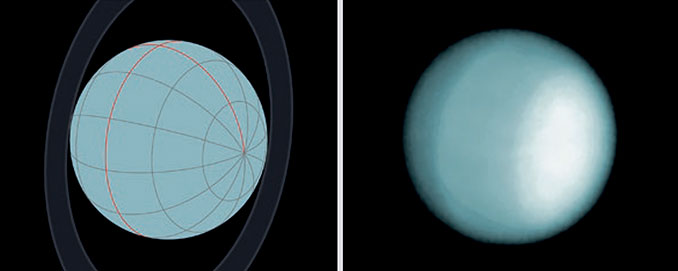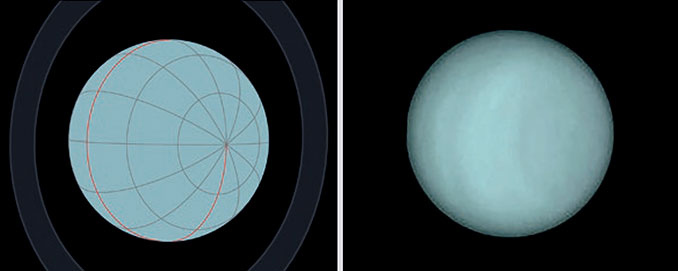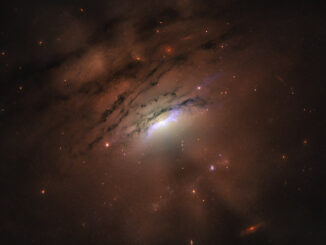
Uranus, the seventh planet from the Sun, comes to opposition on 13 November at 17h UT, located among the stars of Aries. At its vast distance of 2.8 billion kilometres (18.74 astronomical units), more than twice as far away as Saturn and between four and five times Jupiter’s distance, sunlight reflected from the ice-giant planet takes around 2.7 hours to reach Earth. Yet Uranus shines bright enough, at magnitude +5.7, to be faintly visible to the naked eye and appears large enough in apparent diameter for a small telescope to show a perceptible and recognisable blue-green disc.
Uranus is easy to find through a pair of binoculars at just over 2° south of magnitude +4.3 delta Arietis, some 12° north-east of blazing Jupiter. The planet can be observed at an altitude of over 25° from about 7pm to 4.30am GMT. Uranus peaks at a very satisfactory altitude of around 60° at culmination at between 11.30 and midnight.
Uranus is riding relatively high in the sky, but it is a tough planet to fruitfully observe, owing largely to its small apparent diameter and a dearth of easy to see, Jupiter-like detail in its low-surface-brightness cloud tops. A telescope in the 80–100mm (~three- to four-inch) class working at a magnification of around 100x should show Uranus’ 3.7-arcsecond blue-green disc. Upgrade to, say, a 200–250mm (eight- to ten-inch) telescope working at high magnification on a night of fine seeing, and Uranus’ may yield some subtle detail, especially through a green or yellow-green filter.
Uranus has a large family of moons, five of which can be seen or imaged with equipment accessible to amateurs. A telescope in the 300mm (twelve-inch) class should be able to show Oberon and Titania (magnitude +13.9 and +13.7, respectively); they are the outermost of the planet’s five main satellites and the easiest to spot.

Uranus’ odd axial tilt
Bizarrely, Uranus rotates on its side rather than ‘vertically’, as do the other planets. Uranus’ rotational axis is tilted by almost 98 degrees to the ecliptic! Therefore, it spins with that axis parallel to the plane of the Solar System. Uranus’ changing presentation to our line of sight has ramifications for which of Uranus’ faint markings are on show and how difficult they are to view during any given year.
Commonly, a dusky equatorial band(s), or belt(s), are seen, though to their best effect only when the Uranus’ equatorial regions lie face-on to our perspective. Back in 1986, Uranus’ south pole was wholly facing towards us. By 2008 though, the planet’s south pole had rotated out of view and we viewed Uranus’ equatorial regions at their best. Since then, our view of Uranus’ north pole has become ever more prominent – it has appeared particularly bright in high-resolution infra-red filtered images – by 2021it was tilted towards us by around 54 degrees, making it harder to view or image the equatorial bands.







